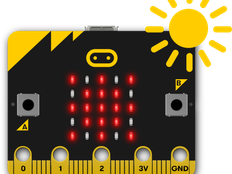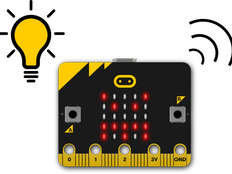第 1 步:制作
它是什么?
您的BBC micro:bit会在黑暗中亮起它的LED显示屏,成为一盏夜灯。
介绍
编程指南
这个项目把micro:bit的LED作为一个光线传感器 输入,在周围变暗时让一个灯自动打开。
micro:bit的光线传感器的亮度范围是0(非常暗)到255(非常亮)。
工作原理
- 代码里的无限循环让micro:bit不断去测量周围的亮度。
- 这里使用了逻辑判断来决定是否打开LED灯。 条件判断指令(if...then...else)用来决定是否打开LED灯。
- 如果周围的亮度低于100,micro:bit显示屏的LED灯会被点亮。 其他情况,程序会用清空屏幕显示的方式关闭所有LED灯。
- 覆盖显示屏或者用别的光源照着它,看看LED灯能否在黑暗时亮起。
- 根据您周边环境的亮度,或许需要调整下面程序代码里的100这个数字。 调整成更大的数字,可以让灯更容易亮起。 调整成更小的数字,让灯只在非常暗的时候亮起。
所需材料
- micro:bit或者是MakeCode模拟器
- MakeCode 或者 Python 编辑器
- 电池盒(选配)
- 光源和覆盖micro:bit的东西
第 2 步:编程
第3步:完善
- 更改图像以在黑暗的环境下显示月亮或星星。
- 将micro:bit装在你的包包或衣服上,以在步行或骑自行车时将其用作额外的安全灯 – 你能否使其闪烁以加强效果?
- 试一下这个MakeCode项目 ,这个项目中,随着micro:bit周围的亮度的高与低,LED分别变得更亮和更暗。 你还能在其他地方看到以这种方式对光做出反应的事物吗?
This content is published under a Creative Commons Attribution-ShareAlike 4.0 International (CC BY-SA 4.0) licence.


